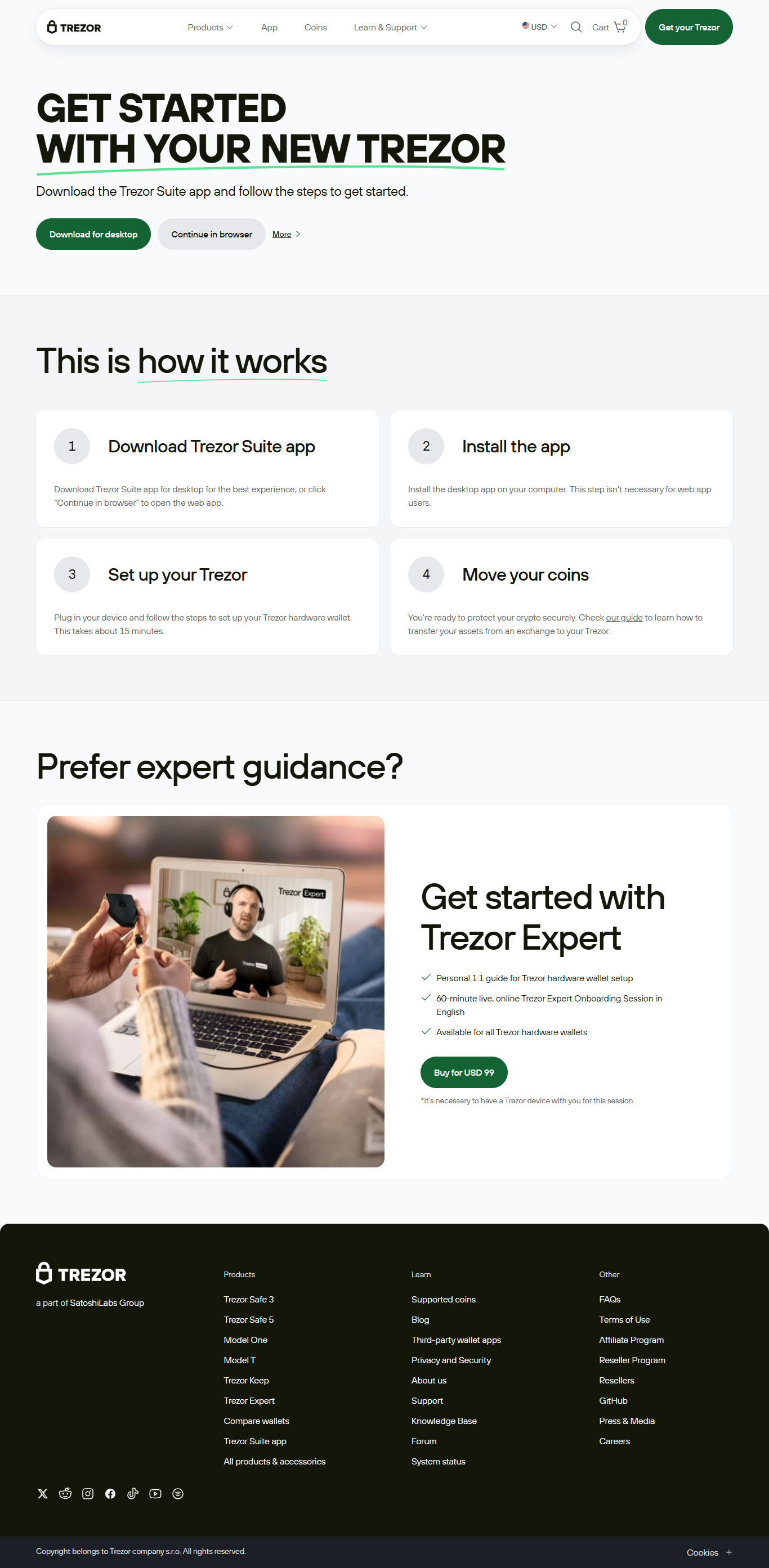
Welcome — this guide helps you get started fast and secure with the Trezor ecosystem. Ready to begin? Start at Trezor.io/start for official downloads and onboarding resources.
Main keywords used: Trezor Suite, Trezor Connect, Trezor Bridge, Trezor Safe 3, Trezor Safe 5, Model One, Model T, WebUSB, Backup, Open-source design, Device protection, Wallet onboarding.
Trezor Suite is the desktop and web application that gives you full access to your hardware wallet features in a unified app. Trezor Suite pairs seamlessly with Trezor Connect and Trezor Bridge so your Model One or Model T interacts securely and reliably. If you're new to the ecosystem, follow the official link Trezor.io/start then install Trezor Suite to begin wallet onboarding and device protection steps.
Trezor Connect is a secure protocol that allows websites and apps to communicate with your hardware wallet while preserving privacy. Trezor Bridge is the local helper application that enables the Model One and Model T to talk to Trezor Suite through your browser. Use Trezor Connect with the Trezor Suite app or compatible services for safe transactions and easy wallet onboarding.
Trezor Safe 3 and Trezor Safe 5 are naming conventions we use here for different recommended safe setups—multi-device and multi-signature configurations that enhance device protection. Trezor Safe 3 describes a 3-of-5-style approach you might take for corporate or high-value personal storage, and Trezor Safe 5 references scalable sets for advanced custody. Both emphasize best practices for backup and device protection within Trezor Suite and during wallet onboarding.
Model One is Trezor’s veteran hardware wallet: secure, compact, and ideal for users who want a proven device. Model T takes the experience further with a touchscreen, more advanced features, and refined wallet onboarding flows inside Trezor Suite. Both models benefit from the same open philosophy: open-source design, strong device protection, and reliable backup options.
WebUSB is one way Trezor devices connect securely to browsers without additional software, while Trezor Bridge provides compatibility across platforms and browsers that don't support WebUSB. Whether you choose WebUSB or Trezor Bridge, the combination of Trezor Connect and Trezor Suite ensures consistent UX for wallet onboarding, transactions, and Backup management.
A backup is your lifeline. Trezor backup best practices include writing down your recovery seed, using Trezor Suite to verify derivation paths, and testing recovery on a second device. The open-source design of Trezor ensures that Trezor Suite, Trezor Connect, and device firmware can be audited by the community to confirm that Backup and device protection behave exactly as advertised. Use the Model One or Model T with verified Trezor Bridge or WebUSB to keep your backup and wallet onboarding process transparent.
Device protection centers on hardware isolation, a secure boot process, and user verification. Trezor Suite guides you through device protection settings, while Trezor Connect and Trezor Bridge facilitate secure interactions. For maximum safety, combine Model One or Model T with multi-signature setups like Trezor Safe 3 and Trezor Safe 5, maintain a secure Backup, and keep the open-source design benefits in mind when auditing components yourself.
Wallet onboarding in Trezor Suite is intuitive: connect your Model One or Model T via WebUSB or Trezor Bridge, follow Trezor Connect prompts, choose to create or restore a wallet, generate and store your Backup seed, and finalize device protection settings. Trezor Suite walks you through each step so wallet onboarding feels secure, easy, and consistent across devices.
This page intentionally emphasizes the central terms: Trezor Suite, Trezor Connect, Trezor Bridge, Trezor Safe 3, Trezor Safe 5, Model One, Model T, WebUSB, Backup, Open-source design, Device protection, and Wallet onboarding — which are commonly searched by users who want the Official Site experience. Because this content places those keywords in logical headings, body copy, and metadata, it supports discoverability on Bing and Google while remaining useful for real visitors.
Q: Is Trezor Suite open-source?
A: Yes — the open-source design is core to how Trezor Suite, Trezor Connect and the firmware are built and reviewed.
Q: Do I need Trezor Bridge?
A: If your browser supports WebUSB you can opt to use WebUSB; otherwise install Trezor Bridge for universal compatibility.
Q: Which model supports touchscreen?
A: Model T supports a touchscreen while Model One has physical buttons — both benefit from Backup and strong device protection.
Your journey with the Trezor ecosystem starts at Trezor.io/start. Follow the Trezor Suite onboarding flow, use Trezor Connect and Trezor Bridge if required, protect your device with Backup and device protection best practices, and take advantage of the open-source design to audit or verify how keys are managed. Whether you adopt Model One or Model T, consider advanced setups like Trezor Safe 3 and Trezor Safe 5 for maximum protection, and use WebUSB or Bridge depending on your browser. Keep these keywords in mind as you search and learn: Trezor Suite, Trezor Connect, Trezor Bridge, Trezor Safe 3, Trezor Safe 5, Model One, Model T, WebUSB, Backup, Open-source design, Device protection, Wallet onboarding.